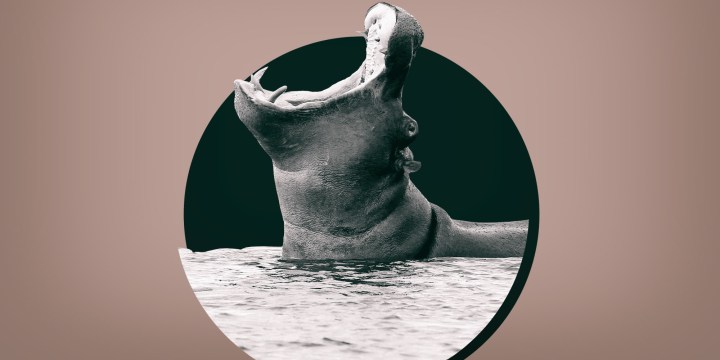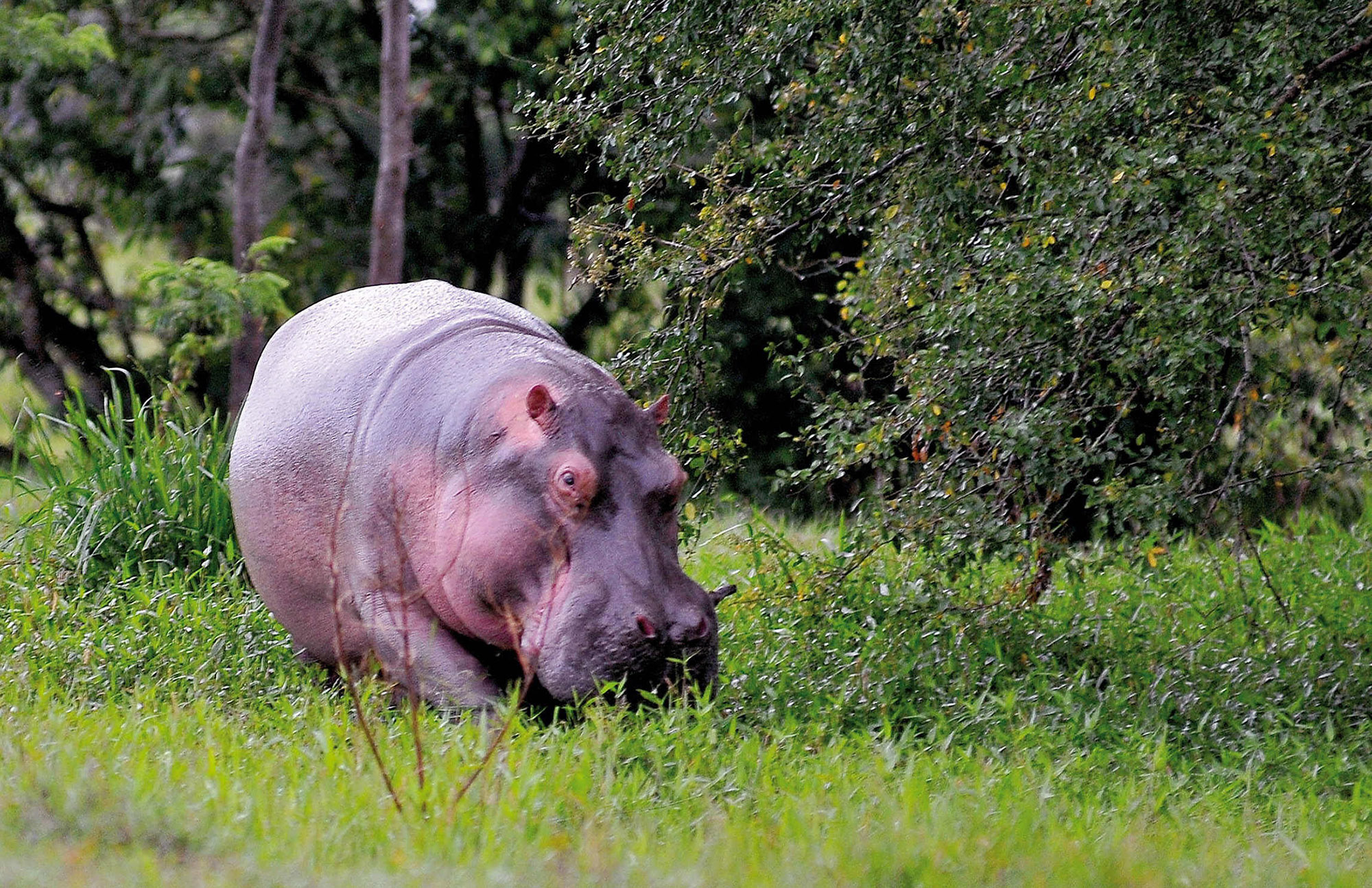COLOMBIA
The hefty problem of castrating Pablo Escobar’s hippos

Just for a day, we are taking a break from the chaos in Washington and elsewhere in the world. Instead, we pause to consider the challenges of dealing with hippos. When the inauguration of President-elect Joe Biden takes place on Wednesday, 20 January, we shall, of course, return to those weighty topics.
Read Daily Maverick’s previous story on Pablo Escobar’s hippos:
The strange tale of Pablo Escobar and his roaming river monsters – hippopotami
I will come right out and say it, hippopotami (or hippopotamuses if you prefer) fascinate me. It probably started when I was very young and had the occasional trip to the Philadelphia Zoological Garden (the US’s oldest zoo), and then, most especially, from seeing a particular episode from the 1940 Disney animated film Fantasia, shown repeatedly on the regular weekend Disney television shows.
The particular segment had been created to illustrate Amilcare Ponchielli’s The Dance of the Hours, the famous ballet from his opera, La Gioconda. On stage that ballet would have been danced by sylph-like female dancers in gauzy costumes and men in costumes that might have referenced classical antiquity. But in the Disney version the male dancers became testosterone-addled crocodiles, with female dancers who were coy ostriches, elephants, and, most especially, very graceful, very weighty, but particularly balletic – hippos.
So, go ahead and watch a key part of this dance, and see if you can ever look at a hippo again in the same way as before:
These memories came back to me when we learnt that a hippo was on the loose and on the move in Chartwell and Fourways, roughly the mid-point between Johannesburg and Pretoria. This is obviously no longer wild, open country. Instead, it is increasingly filling up with residential housing estates, shopping malls and commercial office parks. Not the natural habitat for a hippopotamus, for sure.
This particular creature, possibly Harpo, the rather well-known hippo to residents of the area around Hartbeespoort, might have been the hippo in question closer to the city. Harpo has usually been a denizen of the waters of Hartbeespoort Dam, where the beast’s predilection has been to placidly graze on the abundant – actually, now over-abundant – water hyacinth plants there, among other greenery. And then, perhaps, he, or she, had wandered away in search of still greener pastures, so to speak, and then was tempted by the possibility of finding a swimming pool or two to do what hippos do naturally with water. Or maybe it is yet another hippo on the move. No one knows for sure.
Just as I was learning about this new suburban hippo, I had jokingly suggested to people concerned about the water hyacinth plague in Emmarentia Dam in Johannesburg’s inner suburbs, that a hippo or two – maybe even that elusive Fourways hippo – would make quick work of those plants. But such a new inhabitant would be something of a living, breathing hazard to human users of Emmarentia Dam’s waters, sports enthusiasts like kayakers and the like who would surely be less than happy to share the space with an unpredictable hippo. Well, one has to make sacrifices to deal with the natural balance, and keep control over invasive plants, right?
But then, in yet another cosmic coincidence, I happened upon a story in The Washington Post about the late Colombian drug lord Pablo Escobar’s most amazing legacy, besides the large numbers of cocaine addictions he abetted. It seems Escobar had a hankering for exotic – for Colombia – animals. Like hippos.
He managed to obtain four of the creatures from somewhere, perhaps from South Africa, perhaps elsewhere, and installed them on his estate. Escobar is no longer with us, of course, since 1993. His estate was confiscated by the government and became an amusement park, and most of the exotic animals there were removed. But the hippos were left where they were, or somebody just chose to forget about them. Or, just perhaps, those in charge of removing all the animals realised that capturing and moving a herd of hippo elsewhere would have been something of a bridge too far in the animal relocation business.
In the fullness of time, those four hippos became dozens of the beasts, as they seemed to find the lakes and rivers near Escobar’s former estate congenial for long and happy lives. They even became a tourist attraction for the area, complete with boat tours, T-shirts, key chains, stuffed toys and other souvenirs. They obviously had no natural predators in South America; there was lots to eat that perfectly suited their gustatory preferences, and they bred with the fecundity of rabbits.
As National Geographic reported the story, “For over a decade the Colombian government has been pondering how to best curb the growing population, a strategy largely supported by conservation experts. But not everyone is on board. Without direct evidence that the animals are doing harm, some ecologists argue that there’s no reason to cull or relocate them. Indeed, the hippos could fill in for species that humans pushed to extinction thousands of years ago – an idea known as rewilding.
“When the hippos were left behind, it accidentally kicked off a rewilding experiment that’s now been running for more than 25 years. The first results of this experiment are trickling in and much like the large animals, they’re muddying the waters.
“The hippos have escaped Escobar’s former ranch and moved into Colombia’s main river, the Magdelena. Spread over a growing area, nobody knows exactly how many there are – but estimates indicate there may be a total population between 80 and 100, says Jonathan Shurin, an ecologist with University of California San Diego who studies the animals.
“That’s at least a couple dozen higher than estimates just two years ago. Given that there were four in 1993, the population appears to be growing exponentially. ‘Within a couple of decades, there could be thousands of them.’
“The hippos present quite a problem for the government. David Echeverri, a researcher with the Colombian government’s environmental agency Cornare, which is overseeing the management of the animals, says he has no doubt they act like an invasive species. If allowed to remain unchecked, they will displace endemic animals like otters and manatees, he says. They also pose a danger to local residents since they can be territorial and aggressive, though no serious injuries or deaths have occurred as yet.
“After one hippo was killed in 2009, there was a quick public outcry, quashing any plans to cull them. Instead, the government has been investigating ways to sterilise the creatures, or to move them out of the wild into captive facilities, Echeverri says. But the animals weigh thousands of pounds and aren’t exactly fond of human handling, so relocating or castrating them is dangerous, difficult, and expensive. One juvenile hippo was successfully moved to a Colombian zoo in September 2018, but it cost 15-million pesos (about $4,500).
“For scientists and conservationists, the ultimate question is how these hippos impact the environment. The animals are foreigners, and in their native habitats they can have dramatic impacts on the landscape. Because they feed on land but excrete their waste in water, they funnel nutrients from terrestrial to aquatic environments. And when they alter water chemistry, they can make fish more vulnerable to predators. By simply moving their massive bodies through muddy areas, they can create channels for water flow that alter the structure of wetlands.”
Research published “… in late January in the journal Ecology, found some slight but detectable differences. ‘Hippo lakes have different chemistry and biology than no hippo lakes,’ Shurin says. That’s mainly because the animals are fertilizing the water bodies they frequent with their faeces. That can be problematic; these additional nutrients can lead to toxic algal blooms and even die-offs (something that hippos have caused in human-impacted watersheds in Africa).” That would not be very healthy for the native fish that locals catch.
Still, the ecological impact of Colombia’s burgeoning hippo bloat (the collective noun for hippos) continues to be up for discussion. In The Washington Post story that had gained our attention in the first place, “Locals see the hippos as an unofficial mascot. But to scientists, they are an ecological menace, competing with native wildlife and polluting local waterways. Occasionally, they have even attacked humans.
“Now a study forecasts that the invasive hippo population will swell to almost 1,500 individuals by 2040. At that point, their environmental impacts will be irreversible and their numbers impossible to control. Something needs to be done – and soon.”

A handout photo provided by the Don Juan Magazine on 12 July 2009 shows one of the hippopotamuses imported by late Colombian drug boss Pablo Escobar to his famous farm called Hacienda Napoles in Puerto Berrio, Antioquia, Colombia. (Photo: EPA / JULIAN LINEROS)
In the Post story, the same Dr Echeverri López cited by the National Geographic, explained that, “It was hard enough to find the hippo, a massive, ornery male with a reputation for harassing local ranchers. For three long months, the scientists tracked it through the Colombian countryside, staking out lakes, traipsing through brush and camping on nearby farms.
“But castrating it – that was an almost herculean task. They had to inject it with a potent elephant tranquilliser before it was safe to approach. Even with the hippo immobilised, it was surprisingly difficult to locate his, ahem, parts.
“ ‘It was horrible,’ recalled David Echeverri López, a researcher at the regional environmental agency Cornare who led the 2013 sterilization effort. ‘You cannot just go on the Internet and Google, “What to do with a hippopotamus?” ’ The biologists involved with the task soon realised that the parts to be dealt with were not easily accessible, as they might be with a dog, a cat, a horse, or a cow. They were remarkably inaccessible – male or female.
“Though male hippos have what scientists politely term ‘spatially dynamic testes’ (their genitalia is retractable, and can hide in an opening called the inguinal canal), females’ reproductive organs proved even harder to find.
“ ‘We didn’t understand the female anatomy,’ Echeverri López said. ‘We tried to do it on several occasions and were always unsuccessful.’
“Eventually he found the answer: Trap the hippo in a pen. Make sure the walls are high. Don’t bother with the females. But the process remains dangerous, time-consuming and costly, especially for his low-budget agency. Echeverri López is able to castrate roughly one hippo per year, whereas scientists estimate that the population grows by 10 percent annually.” The numbers are against them it seems, but there is definitely a television show in all of this.
Of course, I have my very own hippo saga as well – although a much more benign one, to be sure, than the one in Colombia. Back in 1976, newly settled in an office in the State Department after a transfer back to the US from South Africa, I was in the Bureau of Educational and Cultural Affairs, dealing with projects for the nations of Southeast Asia.
All manner of issues and projects would come to my in-box, often interesting, sometimes challenging. Early in my assignment, I was asked to approve the transfer of Suzie, the pygmy Nile hippopotamus from the Washington National Zoo to the newly established Singapore Zoo as an example of binational good will.
True, I didn’t have to deal with the actual animal herself by packing her up in a crate, but it was my task to ensure all the appropriate regulations for the international trade of such an animal would be scrupulously observed; that all the paperwork for such a shipment was in order; and that every one of the shipping and related arrangements were properly cleared by appropriately qualified zoologists and exotic animal veterinarians. After these herculean labours, when I returned home that evening and my wife asked me what I had done in my day while she was off teaching, I could tell her I had just tied up all the arrangements needed to send Suzie off for her trip to Singapore.
Suzie, it turned out, became supremely happy in her new home. Over the years, as she moved to a new, natural-style enclosure at the Singapore Wildlife Safari, together with her partner, Congo, she proved remarkably capable of producing offspring.
Suzie died in early 2020 at the ripe old age of 44. That is a very long run for a hippo. At her death, she had given birth to nine children, and had 18 grandchildren, five great-grandchildren and two great-great-grandchildren. Suzie was known to her keepers in Singapore as being a “calm, tender maternal figure to family”.
I now sadly realise that three years after Suzie made her epic journey, when my wife and I were ourselves in Singapore, we neglected to spend much time with Suzie, except for a brief walk past her enclosure and to note how happy she looked. DM



















 Become an Insider
Become an Insider
Comments - Please login in order to comment.